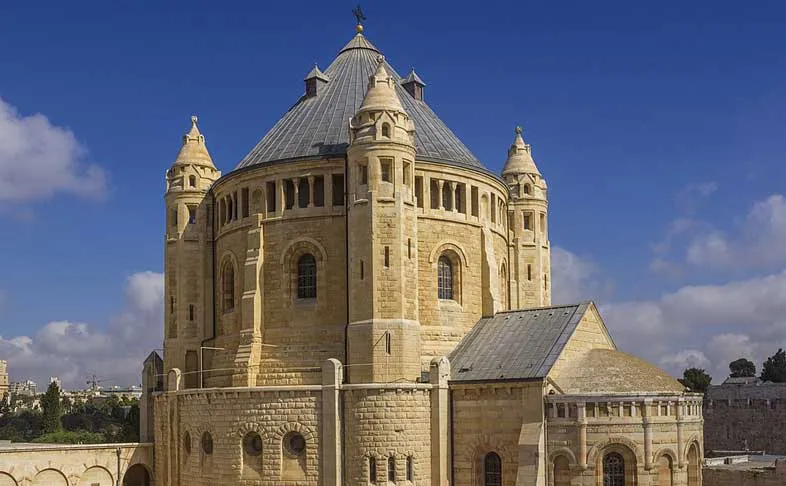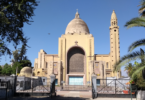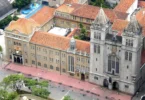
Introduction
Abbey of the Dormition is a Catholic abbey belonging to the Benedictine Order in Jerusalem, on Mount Zion just outside the walls of the Old City near the Zion Gate. The Abbey is said to mark the spot where Mary, mother of Jesus, died.
Between 1998 and 2006 the community was known as the Abbey of Hagia Maria Sion, in reference to the basilica of Hagia Sion that stood on this spot during the Byzantine period, but it resumed the original name during the 2006 celebrations of the monastery’s centenary. “Hagia Maria Sion” is now the name of the foundation supporting the abbey’s buildings, community and academic work.
In recent years the church has become a target for vandalism and desecration by extremist nationalist Israelis.
History of Dormition Abbey, Jerusalem

The Byzantine basilica Hagia Sion was built under John II, Bishop of Jerusalem in the early 5th century. Relics attributed to Saint Stephen were transferred to the church on 26 December 415. The church is shown in the 6th-century Madaba Map. It was destroyed in the 614 sack of Jerusalem by Sasanian king Khosrau II.
Its foundations were recovered in 1899, when the architect and construction manager of the Diocese of Cologne, Heinrich Renard [de] (1868–1928), investigated the site. Bargil Pixner proposed the theory of a pre-Crusader Church of Zion, the continuation of an early Judeo-Christian congregation and their house of worship, which he located on the Madaba Map next to the Hagia Sion basilica.
A monastic order known as the Abbey of Our Lady of Mount Zion was established at the site in the 12th century, with a church built on the ruins of the earlier demolished Byzantine church. The 12th century church was again destroyed in the 13th century, and the monks moved to Sicily. The order was eventually absorbed into the Jesuits in 1617 (the Congregation of Notre-Dame de Sion is an unrelated monastic order founded in 1843).
Modern Building

During his visit to Jerusalem in 1898 for the dedication of the Lutheran Church of the Redeemer, Kaiser Wilhelm II bought this piece of land on Mount Zion for 120,000 German Goldmark from Sultan Abdul Hamid II and presented it to the “German Association of the Holy Land” (“de:Deutscher Verein vom Heiligen Lande”).
Conrad Schick reported about the event, describing the acquired plot of land and showing confidence that the remains of the ancient Zion Church would be discovered under the accumulated dirt.
According to local tradition, it was on this spot, near the site of the Last Supper, that the Blessed Virgin Mary died, or at least ended her worldly existence. Both in Orthodoxy and Catholicism, as in the language of scripture, death is often called a “sleeping” – or “falling asleep” – and this gave the original monastery its name. The church itself is called Basilica of the Assumption (or Dormition). In the Catholic dogma of the Assumption of Mary, Christ’s mother was taken, body and soul, to heaven.
Renard delivered the designs and plans for the Abbey, the direction of construction was entrusted to the architect Theodor Sandel [de], a member of the Temple Society and a resident of Jerusalem. The foundation stone was laid on 7 October 1900. Construction was completed in only ten years; the basilica was dedicated on 10 April 1910 by the Latin Patriarch of Jerusalem. The Abbey was built in an ecclesiastical, neo-Romanesque style that had become the state style of the new Imperial Germany.
The present church is a circular building with several niches containing altars, and a choir. Two spiral staircases lead to the crypt, the site ascribed to the Dormition of the Virgin Mary, and also to the organ-loft and the gallery, from where two of the church’s four towers are accessible.
Out of regard for the nearby Jewish and Muslim sacred place of David’s Tomb, which occupies part of the ground floor of the Cenacle, where it has traditionally been said that the Last Supper took place, the bell tower is set far enough away that its shadow does not touch the tomb, and is therefore not directly accessible from the church.
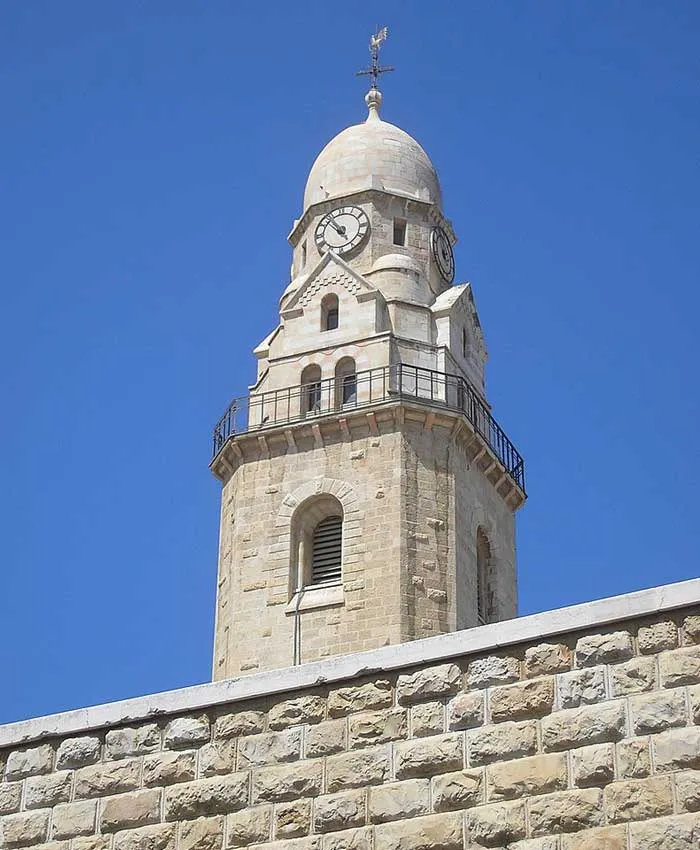
Benedictine Community
The first monks had already been sent to Jerusalem in 1906 from Beuron Archabbey in Germany. They were interned for the first time in 1918–1921, after the end of World War I. In 1926 the monastery was raised to the status of an abbey within the Beuron Congregation. Between 1939 and 1945, the German monks were interned for the second time, and then for the third time as the result of the 1948 Arab-Israeli War. The abbey was located in the Israeli-controlled territory on Mount Zion, across from the Jordanian-controlled territory within the walled city.
In 1951, the abbey was separated from the Beuron Congregation and placed under the direct supervision of the Abbot-Primate of the Benedictines in Rome.
The community elected its own abbot for the first time in 1979.
Theology Seminar
Since 1973 the abbey has been hosting an ecumenical year of study for students of theology from Germany, Austria, and Switzerland. The curriculum encompasses biblical, Eastern Orthodox Church, Judaic, and Islamic studies.

Vandalism
The Dormition Abbey, along with other Christian sites, has been the target of occasional vandalism as a form of “price tag” terrorism by extremist Israeli nationalist religious youths.
In October 2012 and in May and June 2013 the abbey was vandalized with anti-Christian graffiti and insults in Hebrew. The offensive words compared Christians to monkeys and called for revenge against Jesus. Two cars were also covered with graffiti and all tyres were slashed. One of the gates of the nearby Greek Orthodox cemetery was also marked with graffiti. This was allegedly a “price tag” attack carried out by nationalist religious extremists for the dismantling of an illegal outpost Havat Ma’on.
On 26 May 2014 a box of wooden crosses was set ablaze inside the Dormition Abbey. It is believed that this was some sort of failed arson attempt. At the same time of the arson attempt, Pope Francis was conducting a service in the building next door in the Cenacle two floors above the room of King David’s Tomb.
A nationalist religious Jew entered the premises by jumping over a fence in December 2014 and went on to damage a crucifix, a bench, and a number of statues in the cemetery, one of which marked the grave of a monk with Israeli nationality.
In January 2016, vandals wrote slogans on the walls of the Abbey such as “Death to the heathen Christians, the enemies of Israel” and “May his name be obliterated” (whose first letters in Hebrew spell the name of Jesus). Gregory Collins, who was then the abbot, addressed a crowd of demonstrators for peace in Galilee, saying that: “The attack on the church is an attack on all those who believe in a civilization of love and coexistence.”
Dormition of the Mother of God
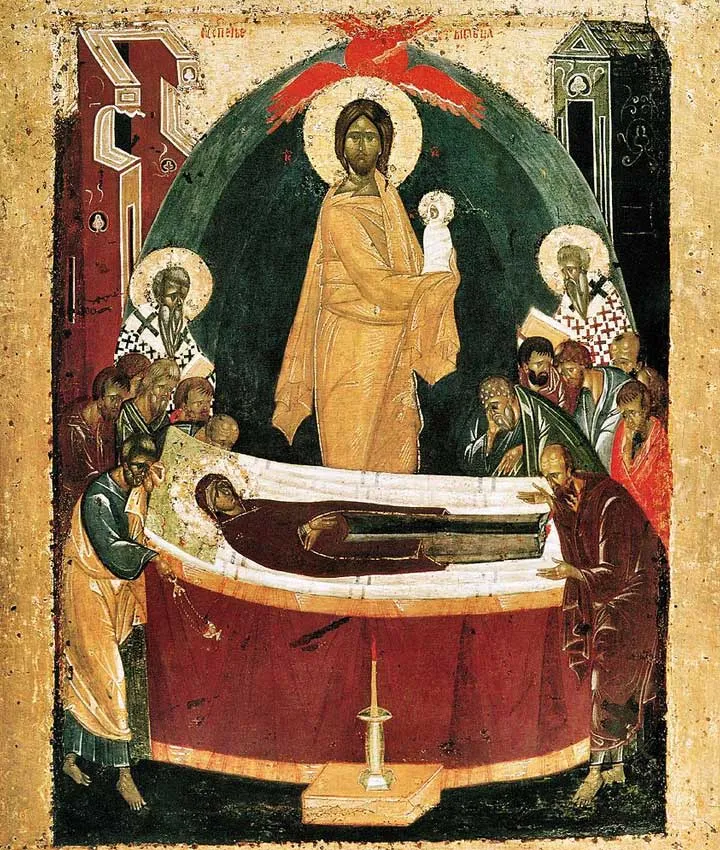
The Dormition of the Mother of God is a Great Feast of the Eastern Orthodox, Oriental Orthodox, and Eastern Catholic Churches (except the East Syriac churches). It celebrates the “falling asleep” (death) of Mary the Theotokos (“Mother of God”, literally translated as God-bearer), and her being taken up into heaven (bodily assumption). It is celebrated on 15 August (28 August N.S. in the Julian Calendar) as the Feast of the Dormition of the Mother of God.
The Armenian Apostolic Church celebrates the Dormition not on a fixed date, but on the Sunday nearest 15 August. In Western Churches the corresponding feast is known as the Assumption of Mary, with the exception of the Scottish Episcopal Church, which has traditionally celebrated the Falling Asleep of the Blessed Virgin Mary on 15 August.
Christian canonical scriptures do not record the death or Dormition of Mary. Hippolytus of Thebes, a 7th- or 8th-century author, writes in his partially preserved chronology of the New Testament that Mary lived for 11 years after the death of Jesus, dying in AD 41.
The use of the term dormition expresses the belief that the Virgin died without suffering, in a state of spiritual peace. This belief does not rest on any scriptural basis, but is affirmed by Orthodox sacred tradition. Some apocryphal writings testify to this opinion, though neither the Orthodox Church nor other Christians accord them scriptural authority.
The Orthodox understanding of the Dormition is compatible with Roman Catholic teaching, and was the dominant belief within the Western Church until late in the Middle Ages, when the slightly different belief in the bodily Assumption of Mary into heaven began to gain ground. Pope Pius XII declared the latter a dogma of the Catholic Church in 1950.

Dormition Fast
The Feast of the Dormition is preceded by a two-week fast, referred to as the Dormition Fast. From August 1 to August 14 (inclusive) Orthodox and Eastern Catholics fast from red meat, poultry, meat products, dairy products (eggs and milk products), fish, oil, and wine. In churches that follow the old or Julian Calendar, the fast is from August 14 to August 28. In the Ethiopian Orthodox Tewahedo Church and the Eritrean Orthodox Tewahedo Church, whose calendar is generally consistent with the Julian Calendar, the dates of the fast are from August 7 to August 22.
The Dormition Fast is a stricter fast than either the Nativity Fast (Advent) or the Apostles’ Fast, with only wine and oil (but no fish) allowed on weekends. As with the other Fasts of the Church year, there is a Great Feast that falls during the Fast; in this case, the Transfiguration (August 6), on which fish, wine and oil are allowed.
In some places, the services on weekdays during the Dormition Fast are similar to the services during Great Lent (with some variations). Many churches and monasteries in the Russian tradition perform the lenten services on at least the first day of the Dormition Fast. In the Greek tradition, during the Fast either the Great Paraklesis (Supplicatory Canon) or the Small Paraklesis is celebrated every evening except Saturday evening and the Eves of the Transfiguration and the Dormition.
The first day of the Dormition Fast is a feast day called the Procession of the Cross (August 1), on which day it is customary to have an outdoor procession and perform the Lesser Blessing of Water. In Eastern Orthodoxy it is also the day of the Holy Seven Maccabees, Martyrs Abimus, Antonius, Gurias, Eleazar, Eusebonus, Alimus, and Marcellus, their mother Solomonia, and their teacher Eleazar. Therefore, the day is sometimes referred to as “Makovei”. Finally it is also considered the First of the three “Feasts of the Saviour” in August, the Feast to the All-Merciful Saviour and the Most Holy Mother of God.

Dormition versus Assumption
Eastern Christians celebrate the Dormition of the Theotokos on August 15 (August 28, N.S. for those following the Julian Calendar), the same calendar day as the Roman Catholic Feast of the Assumption of Mary. “Dormition” and “Assumption” are the different names respectively in use by the Eastern and Western traditions relating to the end of Mary’s life and to her departure from the earth, although the beliefs are not necessarily identical. Both views agree that she was taken up into heaven bodily.
Orthodox view – The Orthodox Church specifically holds one of the two Roman Catholic alternative beliefs, teaching that Mary died a natural death, like any human being; that her soul was received by Christ upon death; and that her body was resurrected on the third day after her repose, at which time she was taken up, bodily only, into heaven when the apostles, miraculously transported from the ends of the earth, found her tomb to be empty. The specific belief of the Orthodox is expressed in their liturgical texts used at the feast of the Dormition.
The Eastern Catholic observance of the feast corresponds to that of their Orthodox counterparts, whether Eastern Orthodox or Oriental Orthodox.
Catholic view – The Catholic doctrine of the Assumption covers Mary’s bodily movement to heaven, but the dogmatic definition avoids saying whether she was dead or alive at that point. The question had long been in dispute in Catholic theology; although Catholic art normally portrays her as alive at the point of assumption, but typically rising from a sarcophagus, many Catholics believe she had died in the normal way.
Pope Pius XII alludes to the fact of her death at least five times, but left open the question of whether or not Mary actually underwent death in connection with her departure, in his Apostolic constitution, Munificentissimus Deus (1950), which dogmatically defined ex cathedra (i.e., infallibly) the Assumption.

Narrative
According to later tradition, Mary, having spent her life after Pentecost supporting and serving the nascent Church, was living in the house of the Apostle John, in Jerusalem, when the Archangel Gabriel revealed to her that her death would occur three days later. The apostles, scattered throughout the world, are said to have been miraculously transported to be at her side when she died.
The sole exception was Thomas, who was preaching in India. He is said to have arrived in a cloud above her tomb exactly three days after her death, and to have seen her body leaving to heaven. He asked her “Where are you going, O Holy One?”, at which she took off her girdle and gave it to him saying “Receive this my friend”, after which she disappeared.
Thomas was taken to his fellow apostles, whom he asked to see her grave, so that he could bid her goodbye. Mary had been buried in Gethsemane, according to her request. When they arrived at the grave, her body was gone, leaving a sweet fragrance.
An apparition is said to have confirmed that Christ had taken her body to heaven after three days to be reunited with her soul. Eastern Orthodox theology teaches that the Theotokos has already undergone the bodily resurrection, which all will experience at the second coming, and stands in heaven in that glorified state which the other righteous ones will only enjoy after the Last Judgment.

Feast Day - 15th August
Annual Feast Day of Dormition of the Mother of God is celebrated on 15th August.
Contact Info
P.O.B. 22, Mount Zion,
Jerusalem, Israel.
Phone No.
Tel : +972 2-565-5330
Accommodations
How to reach the Dormition Abbey
Ben Gurion International Airport in Israel is the nearby Airport to the Dormition Abbey.
City Hall Light Rail Station in Jerusalem, Israel is the nearby Train Station to the Dormition Abbey.

